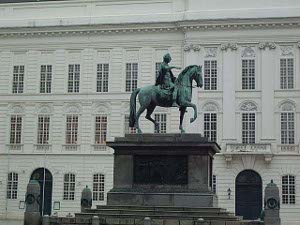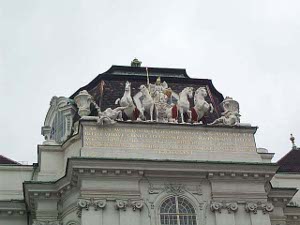We look out of our hotel window at a row of stone maidens, bare to the waist, with arms folded. [Later on we remembered that they're called caryatids.] They're thirty feet up in the air, so nobody on the street looks at them. In the building across the way a man fixes his breakfast in a tidy plain room with a twelve-foot ceiling. As we set out on our first walk, inside the Ring, all we see are buildings with twelve-foot ceilings. A whole city full of them. The typical building is three or four stories tall. This part of Vienna looks like a city built for giants. And it seems that every building is covered with  A Habsburg
sculptures and friezes and shields and emblems. At one time the Habsburgs were quite prolific, and every prince, duke and duchess had their own royal living quarters in Vienna. And every one had several paintings and statues by old masters.
A Habsburg
sculptures and friezes and shields and emblems. At one time the Habsburgs were quite prolific, and every prince, duke and duchess had their own royal living quarters in Vienna. And every one had several paintings and statues by old masters.
It's really amazing about Vienna. The Habsburgs were the most powerful family in Europe. They ruled for six and a half centuries. They assembled great collections of art and great collections of religious treasures. They were devoutly Catholic, and Austria still is. Then suddenly they blundered into the Great War, and paid for it by losing their whole empire. Austria had no tradition of republican government. All the lands of the Austro-Hungarian empire were either made into independent countries like Czechoslovakia and Hungary, or given to their enemies like Italy.
But Austria was left with Vienna, and Vienna is an imperial city. And unlike the other imperial city, Rome, the architectural treasures of the imperial city of Vienna are still standing. The old imperial palace, the Hofburg, takes up block after block after block and includes two churches and countless museums and the national library. It's hard to take the measure of  Hofburg detail
Vienna, so we just started walking. To see the streets, and the people in them.
Hofburg detail
Vienna, so we just started walking. To see the streets, and the people in them.
On our way to the Hofburg we had a great walk. The stores are wonderful, and so varied! Clothes and porcelain and rare books and art galleries and antique stores with real treasures and antique stores with real junk and restaurants of every imaginable national cuisine and lots of ticket agencies.
It's hard to sort out the events in Vienna. There were tens of thousands of tourists, in late September. Once again, we guess it's like Innsbruck: lots of hotel rooms means special packages during the off season to keep the hotels filled. And Vienna has lots of events which are aimed towards tourists. You want to see musicians dressed up the way they did in Mozart's time playing Mozart's music in a hall where Mozart sat? We got it. You want oompah bands and Strauss waltzes? We got it. You want baroque organ music? Go to the church, sit down. People sell tickets and hand out tourist flyers in the streets. Lots of places only take cash.
Having reached the Hofburg, what to see? Each different door to the  In the art museum
building goes to a different museum or library or event or buro (offices). We decided on the imperial treasury, because that got three stars in Michelin.
In the art museum
building goes to a different museum or library or event or buro (offices). We decided on the imperial treasury, because that got three stars in Michelin.
The crown of the Holy Roman Empire, about 1000 years old, was very impressive. But we didn't like the display as much as the crown jewels in the Tower of London. Partly because the Austro-Hungarian monarchy is defunct, while the throne of England is occupied. Partly because there were several large groups -- this time of school kids, rather than tourists -- and the teacher was talking loudly so they would all listen. But mostly because of curatorship. The exhibits in the imperial treasury weren't arranged to tell a story, and the descriptive cards were very matter-of-fact.
There are more museums in the Hofburg, but we elected next to walk across the street to the Historische Kunstmuseum (we guess this means Historical Art Museum rather than Art History Museum) because it has three stars in Michelin.
The building would be worth seeing even if there were no paintings on the walls. It is another one of Vienna's immense, ornate, imperial edifices, with marble pillars and a broad marble staircase and high frescoed ceilings. The walls are full of columns and niches and statuary and plaster reliefs. Here and there paintings and busts of Hapsburgs seem to be frowning at you; great people are seldom painted wearing a smile, did you notice?
 Arcimboldo's The Summer
Arcimboldo's The Summer
In two words, the Historische Kunstmuseum is Old Masters. The wing of Italian masters didn't excite us as much as the wing of Dutch masters.
The Habsburg emperors assembled this collection; they had a good pocketbook for buying works of art. The Michelin guide goes on for three pages just naming famous works. We especially liked the works of Albrecht Durer; Rubens' Self Portrait; the two almost surrealist works by Arcimboldo -- Fire and Summer; and The Tower of Babel by Pieter Breugel the Elder.
We missed about half of the Kunstmuseum, which was closed for restoration; this included all the Egyptian, Greek, and Roman antiquities. Even so, we were somewhat dazed by the grandeur and beauty of this immense collection. We wandered back to our hotel along the Ring of boulevards which surrounds the inner city of Vienna, past statues of Goethe and Schiller.
We found a ticket agency that took credit cards and had two tickets to the Vienna Philharmonic, lucky us! We also spent some time with the concierge and we hope to see the Vienna Boys' Choir tomorrow. Finally, we spent some time trying to get a fast enough internet connection so we could send our travel reports, but no luck yet.
 A Habsburg
sculptures and friezes and shields and emblems. At one time the Habsburgs were quite prolific, and every prince, duke and duchess had their own royal living quarters in Vienna. And every one had several paintings and statues by old masters.
A Habsburg
sculptures and friezes and shields and emblems. At one time the Habsburgs were quite prolific, and every prince, duke and duchess had their own royal living quarters in Vienna. And every one had several paintings and statues by old masters.
 Hofburg detail
Hofburg detail In the art museum
In the art museum Arcimboldo's The Summer
Arcimboldo's The Summer